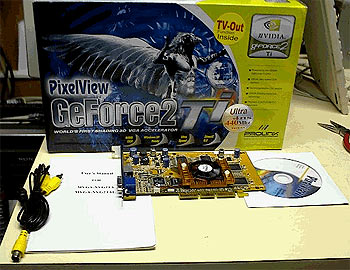NVidia has always liked themes, and that's quite apparent with the release
of the new "Titanium" line of cards. While the GeForce 2 Ti, GF3 Ti200
and GF3 Ti500 are just reworked versions of their older line up. Today, our
focus will be on the GeForce 2 Titanium or specifically the Prolink PixelView
GeForce 2 Ti.
Prolink is relatively unknown to North American consumers - they usually sell their products
to OEM's rather then the general public. Their PixelView GF2 Ti is evidence that they're
trying to gain a foothold on the retail market, and specifically
the value area. The card is rather plain, while it does come with
TV-Output capabilities (courtesy of Conexant's Bt869KRF chipset) it does sport Samsung 4ns RAM clocked
at 440 MHz! That extra memory speed should give the PixelView the edge over it's
competition.
| ProLink PixelView GeForce 2Ti |
 |
Ships with the following:
- Video Card
- TV-out cable
- CD-ROM Drivers
- Instructions
|
NVidia's plan
was to "bring GeForce2 Ultra performance at GeForce2 Pro price" and from what I've
seen on the net, the Ti's go for about the same price as
the Pro's. So what's the difference between the GeForce2 Ti and it's older siblings? Nothing!
It's basically a renamed GeForce2 Ultra core supported by GeForce2
Pro memory. We all know by now that the GeForce2 line of cards, while being very
powerful, are all memory bandwidth limited. Given that, the Ti should perform on
par with a GeForce2 Pro despite the GPU's 50 MHz advantage.
Actually, the card looks more like a GeForce2 GTS then anything
else!
Being the extreme speed freak I am (my toaster
oven even runs at 150V), I always overclock everything. Frankly speaking, since
the PixelView is targgeting the value market, it is less than overclocker friendly. With it's 4ns memory timing, the
memory should be able to do at least 500 MHz with IMHO. However, when I
put it to that setting the test system immediately locked up! Thinking it was a freak
accident, I tried it again. No luck, same deal happened again.
The highest I could set the
memory on the PixelView to was a modest 475 MHz.
It's possible that I couldn't overclock high because I didn't use
ramsinks, however this was not my card and I didn't want to risk damaging it by
adding my own brand of "warrently voiding cooling".
I wasn't too concerned about how high the core would go, as I
mentioned before, the card is memory bandwidth limited. Still all things
considered the core did 285 MHz with out any problems, and this with a
rather plane stock heatsink/fan.
| Test System
Specs: |
| Computer: |
AthlonXP 1800+ (1.53 GHz at 1.67)
256 MB OCZ PC2400 DDR
EPoX
8KHA+
SB Live! Platinum 5.1
30 GB IBM DeskStar 75GXP |
|
Asus V7700 Deluxe (GF2 GTS 200/333)
MSI StarForce 822 (GF3
200/460)
ATI Radeon8500 (8500 275/550)
Prolink PixelView GeForce2 Ti
(GF2 Ti 250/400)
Prolink PixelView GeForce2 Ti (GF2 Ti 285/475) |
| Software: |
Windows 98 SE
DirectX 8.0
Via 4in1
4.35V
DetonatorXP 22.50
ATi Radeon beta drivers 7199 |
| Benchmarks: |
3DMark2000 Ver 1.1
3DMark2001
GLMark
Serious
Sam
Quake III Arena 1.17
Return to Castle
Wolfenstein |
Ok, let the games begin, first up, now it's quite an oldie,
however it still does a good job at determining DirectX7 performance.

